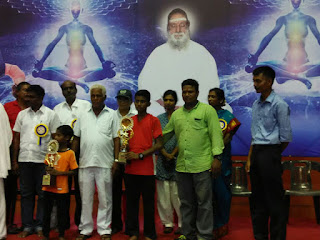சிறுவர்களின் நினைவாற்றலை வளர்க்கும் சிலம்பம்!
நமது பாரம்பரியமான கலை சிலம்பாட்டம் மிக நுணுக்கமானது. சிலம்பாட்டம் பற்றியும், அந்தப் பயிற்சியால் கிடைக்கப்பெறும் நன்மைகள் பற்றியும் விளக்குகிறார் மாதேஷ்வரன். இவர் நூற்றுக்கணக்கான மாணவர்களுக்குக் கிராமியக் கலைப் பயிற்சிகளைக் கற்றுக்கொடுத்து வரும் ஈரோடு, 'கலைத்தாய் அறக்கட்டளை'யின் நிர்வாகி.
* ''ஆதி மனிதன் விலங்குகளிடம் இருந்து தன்னைத் தற்காத்துக்கொள்ள குச்சி, பிரம்புகளைப் பயன்படுத்தினான். பிற்காலத்தில் ஒரு சிலம்பக் குச்சியைக் கொண்டு கை, கால் மற்றும் உடல் அசைவுளைச் செய்து, எதிரியிடம் இருந்து தன்னைத் தற்காத்துக்கொண்டான். அந்தத் தேவைக்காகக் உருவானதே, சிலம்பம். தமிழர்களின் வீரவிளையாட்டான இது, சிலம்பக் குச்சியைப் பயன்படுத்தப்படுவதன் அடிப்படையில் அடிமுறை, தொடுமுறை, சுற்றுமுறை என மூன்று வகைப்படும்.
* குறைந்தபட்சம் ஐந்து வயதிலிருந்து, எல்லா வயதினரும் சிலம்பாட்டத்தை விளையாடலாம். உடல் வெப்பம் ஏறாமல் தடுக்கவல்ல மூங்கில் அல்லது பிரம்பால் செய்யப்பட்ட சிலம்பக் குச்சியில்தான் சிலம்பம் விளையாட வேண்டும். அதுவே பித்தம், மயக்கம் வரக்கூடியவர்கள் பிரம்புக் குச்சியால் செய்யப்பட்ட சிலம்பக் குச்சியைப் பயன்படுத்த வேண்டும்.
* சிலம்பக் குச்சியின் உயரம், விளையாடுபவரின் நெற்றியளவு உயரத்துக்கு இருக்க வேண்டும். சிறுவர்கள், பெரியவர்கள் என்ற பாகுபாடின்றி எந்த வயதினரும் எந்த வயதினரோடும் சிலம்பம் விளையாடலாம்.
சிலம்புக் குச்சியை, முதலில் வீரரின் இடது காலுக்கு முன்பாக வைத்துக்கொண்டு, இடது காலை முன்வைத்துதான் போட்டி அல்லது பயிற்சியைத் தொடங்க வேண்டும். சிலம்பம் கற்றுக்கொள்பவர் மேற்குப் புறத்திலும், கற்றுக் கொடுக்கும் குரு கிழக்குப் புறத்திலும் இருக்க வேண்டும். தளர்வான உடைகள் அணிய வேண்டும்.
* எல்லாவிதமான நிலப்பகுதிகளிலும் சிலம்பம் விளையாடலாம். காலை 6 - 8 மணிக்குட்பட்ட நேரத்தில் சிலம்பம் விளையாடுவது உடல்நலத்துக்குச் சிறந்த பலனைக் கொடுக்கும். உச்சி வெயிலில் சிலம்பம் விளையாடுவதைத் தவிர்க்கலாம்.
* ஒற்றைக் கையிலும், இரண்டு கைகளிலும் சிலம்பம் விளையாடலாம். கைகளுக்கு எந்தளவுக்கு அசைவுகள் கொடுக்கிறோமோ அதற்குச் சமமாக கால்களுக்கும் அசைவுகள் கொடுக்க வேண்டும்.
* விளையாடிக்கொண்டே ஓய்வெடுக்கும் வித்தியாசமான அனுபவத்தை சிலம்பத்தில் பெறமுடியும். வீரர் தொடர்ந்து மூன்றிலிருந்து ஐந்து நிமிடம்வரை அதிக வேகத்தில் விளையாடினால் ஏற்படும் களைப்பைக் குறைக்க, அடவு முறையைப் பயன்படுத்தலாம். இந்த அடவு முறையில், வேகத்தை குறைத்துக்கொண்டு பரதத்தில் காட்டும் அடவுகளைப்போல, மெதுவாக பல்வேறு கம்பு சுற்றும் அடவு முறைகளைச் செய்துகொண்டே களைப்பைப் போக்கிக் கொள்ளலாம். பின்னர் அமர்ந்தும் ஓய்வெடுக்கலாம்.
* வெற்றி தோல்விகளைச் சமமாகப் பாவிக்கக் கற்றுக்கொடுக்கும் சிலம்பு விளையாட்டை சிறுவர்கள் இருந்தே விளையாடுவதன் மூலமாக, தன்னம்பிக்கை, விட்டுக்கொடுக்கும் குணத்துடன் நினைவாற்றலையும் அதிகரித்துக்கொள்ள முடியும். தொடர்ந்து சிலம்பப் பயிற்சி மேற்கொள்ளும்போது கை, கால்கள் பலம் பெறும்.
* சிலம்பம் விளையாடும்போது பசியே எடுக்காது. விளையாடி முடித்ததும் பசி நன்றாகத் தூண்டப்படும். சாப்பிட அடம் செய்யும் குழந்தைகளுக்குச் சிலம்பப் பயிற்சி கொடுப்பதன் மூலம் அவர்களின் பசி தூண்டப்படும் என்பதுடன் உடல் வலிமையும் பெறுவார்கள்.
பெரியவர்கள் தொடர்ந்து சிலம்பாட்டப் பயிற்சியை மேற்கொள்ளும்போது இருதயக் கோளாறுகள், மாரடைப்பு, உயர் ரத்த அழுத்தம் ஆகியவை தவிர்க்கப்பட்டு உடலின் ரத்த ஓட்டம் சீராக இருக்கும்.
சிலம்பம் ஆடி, நினைவாற்றலைப் பெருக்குவோம்.
Courtesy: Vikatan.com

































